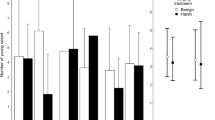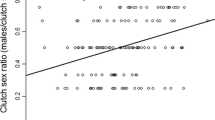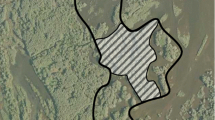Summary
I show how food shortage affects reproduction in a population of Darwin's Medium Ground Finches, Geospiza fortis. Despite the common occurrence of starvation and absence of nest predation, hatching is typically nighly synchronous and adaptive brood reductionappears to be absent. Variation in both growth rates and clutch size in association with the varying conditions is documented. This variation is interpreted as being a direct response to environmental conditions rather than adaptive phenotypic plasticity. I conclude that selection pressures to raise one or two chicks during times of food shortage, or to delay growth rates, are weak or absent.
Similar content being viewed by others
References
Boag PT (1984) Growth and allometry of Darwin's finches (Geospiza) on Isla Daphne Major, Galápagos. J Zool (London) 204:413–441
Boag PT, Grant PR (1984) Darwin's Finches (Geospiza) on Isla Daphne Major, Galápagos: breeding and feeding ecology in a climatically variable environment. Ecol Monogr 54:463–489
Bryant DM (1975) Breeding biology of House martins Delichon urbica in relation to aerial insect abundance. Ibis 117:180–216
Bryant DM (1978) Establishment of weight hierarchies in the broods of house martins Delichon urbica. Ibis 120:16–26
Burley N (1980) Clutch size and clutch overlap: alternative and complementary reproductive tactics. Am Nat 115:223–246
Clark AB, Wilson DS (1981) Avian breeding adaptations: hatching asynchrony, brood reduction and nest failure. Quart Rev Biol 56:253–277
Falconer DS (1981) Introduction to quantitative genetics. 2nd edition. Longman, New York
Gibb J (1950) The breeding biology of the Great and Blue titmice. Ibis 92:507–539
Gibbs HL, Grant PR, Weiland J (1984) Breeding of Darwin's finches at an unusually early age in an El Nino year. Auk 101:872–874
Grant PR, Boag PT (1980) Rainfall on the Galápagos and the demography of Darwin's finches. Auk 97:227–244
Grant PR, Grant BR (1980) The breeding and feeding characteristics of Darwin's finches on Isla Genovesa, Galápagos. Ecol Monogr 50:381–410
Hahn DC (1981) Asynchronous hatching in the Laughing Gull: cutting losses and reducing rivalry. Anim Behav 29:421–427
Horsfall JA (1984) Food supply and egg mass variation in the European Coot. Ecology 65:89–95
Howe HF (1976) Egg size, hatching asynchrony, sex, and brood reduction in the Common Grackle. Ecology 57:1195–1207
Howe HF (1978) Initial investment, clutch size, and brood reduction in the Common Grackle (Quiscalus quiscula L.). Ecology 59:1109–1122
Lack D (1968) Ecological adaptation for breeding in birds. Methuen, London, England
Millington SJ, Grant PR (1983) Feeding ecology and territoriality of the Cactus Finch Geospiza scandens on Isla Daphne Major, Galápagos. Oecologia (Berlin) 58:76–83
Millington SJ, Grant PR (1984) The breeding ecology of the Cactus Finch Geospiza scandens on Isla Daphne Major, Galápagos. Ardea 72:177–188
O'Connor RJ (1977) Growth strategies in nestling passerines. Living Bird 16:209–238
Price TD (1984a) The evolution of sexual size dimorphism in Darwin's fisnches. Am Nat 123:500–518
Price TD (1984b) Sexual selection on body size, plumage, and territory variables in a populaton of Darwin's finches. Evolution 38:327–341
Price TD, Grant PR (1984) Life history traits and natural selection for small body size in a population of Darwin's finches. Evolution 38:483–494
Price TD, Grant PR (1985) The evolution of ontogeny in Darwin's finches: a quantitative genetic approach. Am Nat 125:169–188
Richter WE (1984) Nestling survival and growth in the Yellowheaded blackbird Xanthocephalus xanthocephalus. Ecology 65:597–608
Ricklefs RE (1965) Brood reduction in the Curve-billed Thrasher. Condor 67:505–510
Ricklefs RE (1968) Patterns of growth in birds. 110:419–451
Ricklefs RE (1976) Growth rates of birds in the humid New World tropics. Ibis 118:179–207
Ricklefs RE (1979) Adaptation, constraint, and compromise in avian postnatal development. Biol Rev 54:269–290
Ricklefs RE (1982) Some considerations on sibling competition and avian growth rates. Auk 99:141–147
Werschkul DB, Jackson JA (1979) Sibling competition and avian growth rates. Ibis 121:97–102
Zach R (1982) Hatching asynchrony, egg size, growth and fledging in tree swallows. Auk 99:695–700
Author information
Authors and Affiliations
Rights and permissions
About this article
Cite this article
Price, T. Reproductive responses to varying food supply in a population of Darwin's finches: Clutch size, growth rates and hatching synchrony. Oecologia 66, 411–416 (1985). https://doi.org/10.1007/BF00378307
Received:
Issue Date:
DOI: https://doi.org/10.1007/BF00378307




